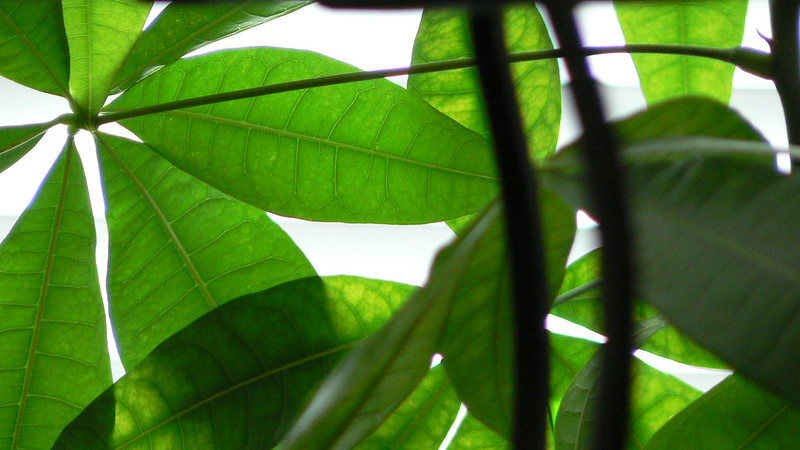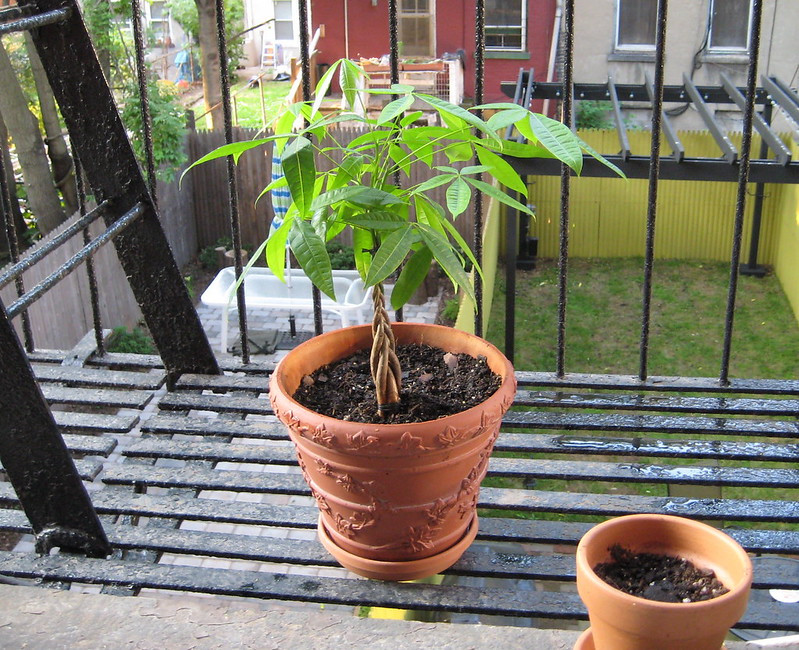The Money Tree, scientifically known as Pachira aquatica, is a popular houseplant celebrated not only for its lush appearance but also for the Feng Shui belief that it attracts good fortune. Native to the tropical wetlands of Central and South America, this plant brings a touch of the exotic indoors. In homes, the Pachira aquatica, often simply called a Money Tree, thrives as an easy-care plant, typically reaching heights of 3 to 6 feet. Its distinctive feature is a braided trunk, created by weaving together the stems of multiple young plants, topped with whorls of vibrant, compound leaves.
 Lush green compound leaves of a Money Tree Pachira Aquatica plant, showcasing its vibrant foliage.
Lush green compound leaves of a Money Tree Pachira Aquatica plant, showcasing its vibrant foliage.
While the Money Tree (Pachira aquatica) is known for its resilience and adaptability, understanding its needs as a tropical wetland species is key to ensuring its health and vigor. Providing the right balance of moisture, humidity, and light will unlock the full potential of your Pachira aquatica, allowing it to flourish in your home.
Optimal Light Conditions for Your Money Tree
For ideal growth, the Money Tree (Pachira aquatica) prefers bright, indirect light, mimicking its natural habitat where taller trees filter the harsh sunlight. While it can tolerate partial shade, placing your Money Tree in a room that receives ample sunlight throughout the day is beneficial, as long as it’s shielded from direct sun exposure. Direct sunlight can scorch the leaves, detracting from the plant’s aesthetic appeal. If your Pachira aquatica is in a location with insufficient light, you might notice a decline in its health and vibrancy over time. To promote even growth, rotate your Money Tree each time you water it, ensuring all sides of the plant receive adequate light.
Watering and Humidity Needs of Pachira Aquatica
Watering your Money Tree (Pachira aquatica) correctly involves replicating its native environment’s wet-dry cycle. Use a pot with drainage holes and well-draining soil to prevent waterlogging. When watering, thoroughly saturate the soil, ensuring it’s moist but not soggy. After watering, allow any excess water to drain away and discard any that collects in the saucer to avoid root rot. It’s crucial to let the topsoil become nearly dry between waterings, but avoid allowing the roots to completely dry out. A moisture meter can be a helpful tool to accurately gauge the soil moisture level near the roots of your Pachira aquatica.
During winter, indoor conditions can change, affecting how quickly your Money Tree’s soil dries. Heated homes can lead to drier air, potentially increasing evaporation, while reduced daylight hours might slow down water uptake. Adjust your watering frequency accordingly to these seasonal changes.
Humidity is another important factor for a healthy Money Tree (Pachira aquatica). Aim for a humidity level of around 50%. If your home’s air is dry, especially during winter, you can increase humidity by placing the plant on a tray filled with wet pebbles. As the water evaporates, it will create a humid microclimate around your Pachira aquatica, helping to prevent the leaves from becoming dry and crispy.
Temperature Requirements for a Thriving Money Tree
As a tropical plant, Pachira aquatica thrives in warm household temperatures, ideally between 65°F and 85°F (18°C – 29°C). Position your Money Tree in a location with good air circulation, away from drafts from windows or air conditioning vents, and also away from direct heat sources like heating vents. Sudden temperature fluctuations can stress your Pachira aquatica, often leading to leaf drop. Maintaining a consistent environment is key to its well-being.
Re-potting Your Pachira Aquatica Money Tree
Repotting your Money Tree (Pachira aquatica) is typically necessary every two to three years, usually in the spring. When repotting, choose a pot that is only slightly larger than the current one and ensure it has drainage holes. Use a high-quality houseplant potting mix that is both moisture-retentive and well-draining. You can create your own mix by combining organic compost, coarse builder’s sand or perlite for drainage, and peat or coco coir for water retention.
When repotting your Pachira aquatica, handle the roots gently to minimize disturbance. Money Trees can be sensitive to root disruption and may react by dropping leaves. Should leaf drop occur, don’t be alarmed; with proper care, new leaves should emerge as the plant recovers.
Nutritional Needs of Your Money Tree
To support vigorous growth, feed your Pachira aquatica with a balanced, organic fertilizer diluted to half strength every two weeks during the active growing season, from March to September. Fertilizing during the dormant months (fall and winter) is not necessary.
Pruning and Shaping Your Pachira Aquatica
Regular pruning helps maintain the shape and health of your Money Tree (Pachira aquatica). Dead leaves or branches can be removed at any time using sterile pruning shears, cutting back to healthy growth. You can also prune new shoots that emerge from the base or trunk to maintain the desired form.
For more significant shaping, prune your Money Tree in the spring when it’s entering its active growth phase. Pruning during this time supports healthy regrowth. When pruning, cut just above a node or leaf, removing no more than half the length of a stem. Avoid cutting into any braided sections of the trunk. Pruning encourages new growth from the cut areas, helping to maintain a compact and attractive shape.
 Braided trunk Money Tree Pachira Aquatica, a popular style showcasing multiple stems interwoven for a decorative houseplant.
Braided trunk Money Tree Pachira Aquatica, a popular style showcasing multiple stems interwoven for a decorative houseplant.
Common Issues and How to Address Them
Leaf drop is a common reaction in Money Trees (Pachira aquatica) to stress. Overwatering, underwatering, sudden changes in temperature, drafts, or relocation can all trigger leaf drop. Assess your plant’s environment and care routine to identify and correct the issue. Usually, with consistent care in a stable environment, the leaves will return.
Yellowing leaves and leaf drop in the fall can be a natural response to reduced daylight. Increasing light exposure can help, and typically, new leaves will grow back in the spring.
Crispy, curling leaves often indicate low humidity, inconsistent watering, or insufficient light. Increase humidity and ensure a consistent watering schedule and adequate indirect light.
Yellowing leaves accompanied by stem rot are signs of overwatering or poorly draining soil. Ensure your pot has drainage holes and allow excess water to drain after watering.
Scale insects can sometimes infest Money Trees. Regularly inspect your plant, especially in crevices along stems and leaves. If scale is present, isolate the plant to prevent spread. Remove scale insects by dabbing them with a cotton swab dipped in rubbing alcohol, or by wiping them off with a damp cloth. Regularly check your plant and repeat treatment as needed until the infestation is controlled.
Conclusion: Nurturing Your Money Tree Pachira Aquatica
The Money Tree (Pachira aquatica) is a rewarding and attractive houseplant to grow, bringing a touch of tropical greenery and a sense of good fortune to your home. By understanding and meeting its needs for light, water, humidity, and warmth, you can ensure your Pachira aquatica thrives, providing years of enjoyment and beauty. Consistent care and attention will keep your Money Tree healthy, vibrant, and a cherished part of your indoor plant collection.
